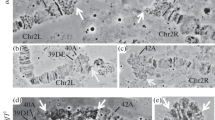Abstract
Drosophila nasutoides is distinguished from other Drosophila species in that the metaphase karyotype shows a pair of very large V-shaped chromosomes. With Giemsa, a distinctive C-banding pattern is revealed along the arms of this large chromosome, indicating a largely heterochromatic nature. Furthermore, the banding patterns of the arms are symmerical, indicating that it is an iso-chromosome. A comparison between the metaphase karyotype and polytene chromosomes suggests that the large V chromosome appears as the dot chromosome in polytene squash. One autosome has twice the arm length of typical Drosophila polytene chromosomes and arose either by centric fusion and a pericentric inversion, or by translocation connecting distal ends with a subsequent loss of one centromere. This chromosome appears to have a short arm which ectopically pairs with the proximal region of the long arm, representing a duplication of about ten bands. When the nuclear DNA is examined by neutral CsCl gradient, four satellites are observed. As much as sixty percent of the total DNA appears as satellites in the lysate of larval brains. No satellite was detectable in the lysate of salivary glands. These observations led us to suggest that the heterochromatic nature of the large V chromosome is due to the presence of all four satellites in this chromosome and that this large chromosome appears as the dot because of the under-reduplication of the satellites during polytenization.
Similar content being viewed by others
References
Botchan, M., Kram, R., Schmid, C. W., Hearst, J. E.: Isolation and chromosomal localization of highly repeated DNA sequences in Drosophila melanogaster. Proc. nat. Acad. Sci. (Wash.) 68, 1125–1129 (1971)
Clayton, F.: Preliminary report on the karyotypes of Hawaiian Drosophilidae. Univ. Texas Publ. 6615, 397–404 (1966)
Clayton, F.: Variations in the metaphase chromosomes of Hawaiian Drosophilidae. Univ. Texas Publ. 6918, 95–125 (1969)
Dickson, E., Boyd, J. B., Laird, C. D.: Sequence diversity of polytene chromosome DNA from Drosophila hydei. J. molec. Biol. 61, 615–627 (1971)
Flamm, W. G., Walker, P. M. B., McCallum, M.: Some properties of the single strands isolated from the DNA of the nuclear satellite of the mouse (Mus musculus). J. molec. Biol. 40, 423–443 (1969)
Gall, J. G., Cohen, E. H., Polan, M. L.: Repetitive DNA sequences in Drosophila. Chromosoma (Berl.) 33, 319–344 (1971)
Hennig, W., Hennig, I., Stein, H.: Repeated sequences in the DNA of Drosophila and their localization in giant chromosomes. Chromosoma (Berl.) 32, 31–63 (1970)
Hsu, T. C.: Heterochromatin pattern in metaphase chromosomes of Drosophila melanogaster. J. Hered. 62, 285–287 (1971)
Hsu, T. C.: Longitudinal differentiation of chromosomes. Ann. Rev. Genet. 7, 153–176 (1973)
Lakhotia, S. C.: EM autographic studies on polytene nuclei of Drosophila melanogaster. III. Localization of non-replicating chromatin in the chromocentric heterochromatin. Chromosoma (Berl.) 46, 145–160 (1974)
Lee, C. S.: DNA synthesis in larval brains of Drosophila nasutoides. Biochem. Genet. 12, 475–483 (1974)
Patterson, J. T., Stone, W. S.: Evolution in the genus Drosophila, 610 pp. New York: The Macmillan Company 1952
Rae, P.: Chromosomal distribution of rapidly reannealing DNA in Drosophila melanogaster. Proc, nat, Acad. Sci. (Wash.) 67, 1018–1025 (1970)
Rudkin, G. T.: Non-replicating DNA in Drosophila. Genetics (Suppl.) 61, 227–238 (1969)
Szybalski, W.: Use of cesium sulfate for equilibrium density gradient centrifugation. In: Methods in enzymology, vol. XII B, p. 330–359 (L. Grossman and K. Moldave, eds.). New York: Academic Press, Inc. 1968
Vinograd, J., Hearst, J. E.: Equilibrium sedimentation of macromolecules and viruses in a density gradient. Fortschr. Chem. Org. Naturstoffe 20, 372–422 (1962)
Wasserman, M., Cytological studies of the repleta group of the genus Drosophila. V. The mulleri subgroup. Univ. Texas Publ. 6205, 85–117 (1962)
Wheeler, L. L., Capps, A. S., Wilson, F. D.: The heterochromatic chromosome of D. nasutoides. Dros. Inf. Serv. 50, 68 (1973)
Wilson, F., Wheeler, M. R., Harget, M., Kambysellis, M.: Cytogenetic relations in the Drosophila nasuta subgroup of the immigrans group of species. Univ. Texas Publ. 6918, 207–254 (1969)
Yoon, J. S., Resch, K., Wheeler, M. R.: Cytogenetic relationships in Hawaiian species of Drosophila. II. The Drosophila mimica subgroup of the “modified mouthparts” species group. Univ. Texas Publ. 7213, 201–212 (1972)
Author information
Authors and Affiliations
Rights and permissions
About this article
Cite this article
Cordeiro, M., Wheeler, L., Lee, C.S. et al. Heterochromatic chromosomes and satellite DNAs of Drosophila nasutoides . Chromosoma 51, 65–73 (1975). https://doi.org/10.1007/BF00285809
Received:
Accepted:
Issue Date:
DOI: https://doi.org/10.1007/BF00285809




